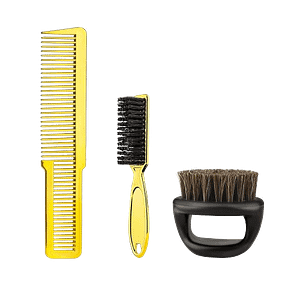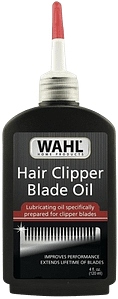Hair clipper care is essential for hygienic purposes to avoid damage, uncleanliness, and medical problems. But is the alcohol only the disinfecting solution to clean the clipper blade? There are alternative alcohol-free methods that you can apply for maintenance.
Proper cleaning is essential for optimal performance and longevity when maintaining hair clippers.
However, many individuals prefer to avoid using alcoholic cleaning solutions due to various reasons, such as sensitivity to alcohol, concerns about residue, or simply preferring other cleaning methods.
This article will teach us how to use non-alcoholic cleansers to clean hair trimmers.
Why Clean Hair Clippers Without Alcohol?
Hair clippers play a significant role in grooming routines for personal use or professional settings.
Frequent use can accumulate hair, debris, and product residue over time, affecting performance and efficiency and causing hygienic issues.
Cleaning your hair clippers helps maintain functionality, extend lifespan, and ensure healthful usage.
Alcohol-free solutions are less irritating to the skin. They can effectively remove the debris and buildup and leave no residue on the clipper blades. These cleaning agents are safe to apply to various hair-cutting machines. The chances of corrosion or damage are less because of non-drying behavior.
While alcoholic cleaning agents may not suit everyone, they may cause allergies or alcohol sensitivity and leave residue behind. Moreover, alcohol can dry the clipper blades and other components, which might lead to corrosion or dulling of the blades over time.
No doubt, they have long been used to sanitize various tools, but there are cons to using alcohol on hair clippers.
Essential Tools and materials
To properly clean hair clippers without alcohol and ensure their optimal maintenance, you will need a few essential tools and materials.
Cleaning Brushes and Combs for Hair Removal
Cleaning brushes and combs are essential for removing hair and debris from your hair clippers. These tools come in various sizes and shapes, allowing you to access hard-to-reach areas and effectively dislodge trapped hairs.
Look for brushes and combs specifically designed for clipper cleaning, as they often have bristles or teeth with the right stiffness to remove buildup without damaging the clipper blades.
Barber Cleaning Brush and Comb Set
Check Price on AmazonDisassembling Tools for Clipper Maintenance
You may need to disassemble your hair clippers for a thorough cleaning. Having the appropriate disassembly tools on hand can make this process much easier, and for this, you can pick the screwdriver or substitute available at home.
SUNHZMCKP 8 in 1 Screwdriver for Outdoor and Daily Repair Tools
Check Price on AmazonNon-Alcoholic Cleaning Solutions and Sanitizers
When choosing cleaning solutions for your hair clippers, opt for non-alcoholic alternatives to avoid the potential drawbacks of alcoholic solutions.
BRIOTECH Sanitizer & Disinfectant
Check Price on AmazonThese solutions often contain disinfecting agents to kill bacteria and provide effective cleaning without the drying or corrosive effects of alcohol.
Additionally, consider using sanitizers or disinfecting sprays designed for hair clippers to ensure optimal hygiene.
Lubricating oil for smooth operation
Lubrication is a crucial step in maintaining the performance and longevity of your hair clippers. After cleaning, it’s important to lubricate the clipper blades and other moving parts to minimize friction and ensure smooth operation.
Look for clipper oil or lubricating oil specifically recommended for hair clippers. These oils are designed to reduce wear and tear on the blades, maintain their sharpness, and prevent rust or corrosion.
A Step-by-Step Guide to Cleaning Hair Clippers Without Alcohol
Properly cleaning hair clippers without alcohol is vital for maintenance.
1. Cleaning Brushes and Combs
Removing Hair and Debris Effectively:
- Start by powering off and unplugging the hair clippers.
- Use a cleaning brush or comb to gently remove loose hair or debris from the clipper blades and other parts.
- Pay special attention to the areas around the blades, as hair tends to accumulate there.
Preventing Clogs and Buildup
- Regularly clean the brush or comb to remove the collected hair and debris.
- Ensure all hair and debris are completely removed from the clipper to prevent clogs and buildup that can affect performance.
2. Disassembling the Clipper
Necessary Steps for Safe Disassembly:
- Refer to the manufacturer’s instructions to identify the specific disassembly steps for your hair clippers.
- Use the appropriate disassembly tools, such as screwdrivers or clipper-specific disassembly tools, to remove any removable parts.
Identifying Removable Parts
- Take note of the parts that can be safely removed for a more thorough cleaning.
- Common removable parts may include the blade assembly, blade guards, and guide combs.
3. Removing Hair and Debris
Detailed Instructions for Thorough Cleaning
- Clean the removable parts by rinsing them under warm running water to remove hair and debris.
- Use a brush or toothbrush with mild soap or a non-alcoholic cleaning solution to scrub the parts gently.
- Pay attention to hard-to-reach areas and crevices where hair and buildup may be present.
Using Appropriate Tools for Different Areas:
- For hard-to-reach areas, use cotton swabs or small cleaning brushes to remove stubborn residue or buildup.
- Avoid using excessive force to prevent damage to the clipper components.
4. Choosing Non-Alcoholic Cleaning Solutions
Recommended Cleaning Solutions for Hair Clippers:
- Look for non-alcoholic cleaning solutions specifically formulated for hair clippers.
- These solutions often contain disinfecting agents to kill bacteria and provide effective cleaning without the drying or corrosive effects of alcohol.
Benefits of Using Non-Alcoholic Alternatives:
- Non-alcoholic cleaning solutions are generally gentler on clipper components and leave little to no residue.
- They offer effective cleaning while preserving your hair clippers’ performance, longevity, and hygiene.
5. Sanitizing the Clipper Blades
Effective Methods for Sterilizing Without Alcohol:
- Soak a clean cloth or cotton pad in a non-alcoholic disinfecting solution to sanitize the clipper blades.
- Gently wipe the blades to remove any remaining debris and kill bacteria or germs.
- Ensure that the blades are completely dry before reassembling the clipper.
Ensuring Hygienic Practices:
- Clean and sanitize your hair clippers regularly, especially when used on different individuals or in a professional setting.
- Follow the manufacturer’s recommendations for the frequency of cleaning and sanitizing to maintain optimal hygiene.
6. Lubrication for Smooth Operation
Importance of Lubricating Clipper Blades:
- Apply a few drops of clipper or lubricating oil specifically recommended for hair clippers to the blade surface.
- Move the blades back and forth to distribute the oil evenly and ensure smoothness.
You can check out the best substitute oil for hair clippers if you don’t know.
Recommended Lubricants and Application Techniques:
- Look for lubricating oils that are specifically designed for hair clippers.
- Apply a small amount of oil to the clipper blades, focusing on the moving parts and contact surfaces.
- Move the blades back and forth or turn on the clipper for a few seconds to allow the oil to spread and coat the surfaces effectively.
Wahl Premium Hair Clipper Blade Oil
Check Price on Amazon7. Reassembling and testing
Proper Reassembly of Clipper Components:
- Refer to the manufacturer’s instructions to ensure the correct reassembly of the hair clipper.
- Place the cleaned and dried removable parts back in their respective positions.
- Securely fasten any screws or clips that hold the components together.
Testing Functionality and Performance:
- Before using the clipper, double-check that all parts are properly reassembled.
- Plug in the clipper and turn it on to test its functionality and performance.
- Ensure the blades are cutting smoothly and the clipper operates as expected.
Alternative Methods for Alcohol-Free Cleaning
While non-alcoholic cleaning solutions are a great alternative to alcoholic cleaners, other methods exist for cleaning hair clippers without alcohol.
Vinegar-based cleaning solution
Recipe for a Vinegar-Based Cleaning Solution:
- Mix equal parts of distilled white vinegar and water in a container.
- Optionally, you can add a few drops of antibacterial essential oil (such as tea tree oil) for added disinfecting properties.
Steps for Cleaning Hair Clippers with Vinegar:
- Power off and unplug the hair clippers.
- Dip a clean cloth or cotton pad into the vinegar solution, ensuring it is damp but not soaked.
- Gently wipe the clipper blades, removing any debris or residue.
- Use a cleaning brush or toothbrush to scrub hard-to-reach areas.
- Rinse the blades with water and dry them thoroughly before reassembling the clipper.
Hydrogen Peroxide Solution
Preparing a Hydrogen Peroxide Cleaning Solution:
Mix equal parts of hydrogen peroxide (3% concentration) and water in a container.
How to Use Hydrogen Peroxide for Clipper Cleaning:
- Make sure the hair clippers are powered off and unplugged.
- Dampen a cloth or cotton pad with the hydrogen peroxide solution.
- Wipe the clipper blades, ensuring complete coverage.
- Let the solution sit on the blades for a few minutes to disinfect.
- Rinse the blades with water and thoroughly dry them before reassembling the clipper.
Dish Soap and Water Mixture
Creating a Gentle Dish Soap and Water Solution:
- Fill a container with warm water.
- Add a few drops of mild dish soap and mix until it forms a soapy solution.
Steps for Cleaning Hair Clippers with Dish Soap:
- Ensure the hair clippers are powered off and unplugged.
- Submerge the clipper blades in the dish soap and water mixture.
- Use a cleaning brush or toothbrush to scrub the blades and other parts.
- Pay attention to removing any hair or residue.
- Rinse the blades with water and thoroughly dry them before reassembling the clipper.
Conclusion
Following the provided guide and incorporating the alternative cleaning methods discussed, you can effectively clean your hair clippers without alcohol and ensure optimal functionality.
You should also know when to use alcoholic and non-alcoholic agents.
Thanks for reading this article. We hope it has provided valuable insights and practical guidance on cleaning hair clippers without alcohol.




